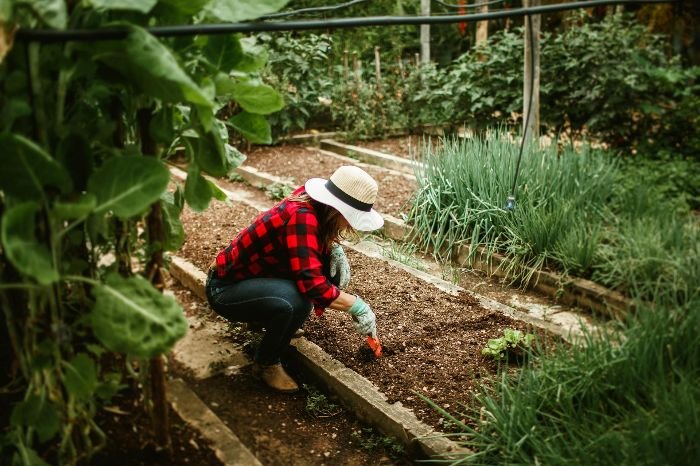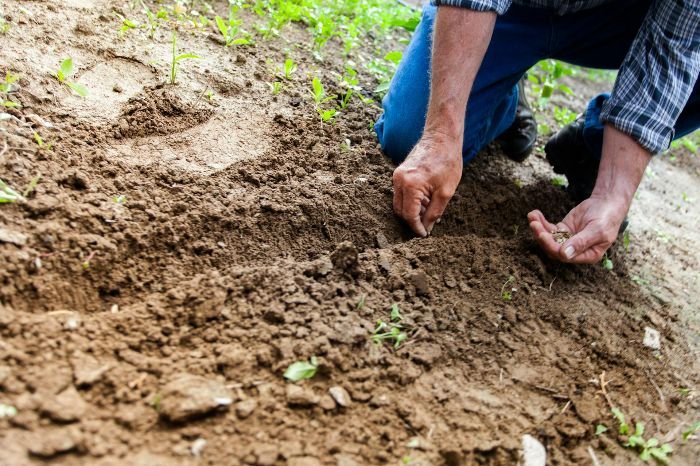Updated October 17, 2025
Conventional gardening often treats nature as something to control. Permaculture takes the opposite approach – designing systems that align with natural processes instead of resisting them. The goal is long-term productivity with minimal external inputs.
By observing how water flows, how sunlight moves, and how plants interact, you can structure a garden that regenerates itself. Healthy soil, reduced waste, and resilient ecosystems become the byproducts of design – not side concerns. This isn’t just a method for growing food – it’s a way to build gardens that sustain themselves and the people who tend them.
Key Takeaways
- Permaculture uses ecological design to create productive, low-maintenance gardens.
- Core ethics – earth care, people care, fair share – guide all design decisions.
- Observing natural patterns helps align your garden with its environment.
- Zoning and companion planting improve efficiency and plant health.
- Soil building, water harvesting, and habitat creation increase resilience.
- Long-term sustainability is achieved by working with nature, not against it.
Table of Contents
Understanding Permaculture – A Sustainable Gardening Approach
Permaculture is more than a gardening method – it’s a philosophy of design rooted in ecology. It emphasizes working with natural systems rather than imposing artificial control. In the garden, this translates into sustainable practices that improve soil health, conserve resources, and foster long-term resilience. Below we explore the origins, ethical foundation, and core benefits of integrating permaculture into home gardens.
What is Permaculture?
Originating in the 1970s from the work of Bill Mollison and David Holmgren, permaculture blends the words “permanent” and “agriculture.” It draws from ecological science, traditional farming, and systems thinking to create environments that sustain themselves with minimal external inputs. Applied to gardening, it means designing systems that are regenerative – producing food, supporting biodiversity, and reducing maintenance over time.
The Core Ethics of Permaculture
Permaculture design is grounded in three core ethics that guide every decision:
- Care for the Earth – Protect and restore natural systems like soil, water, and biodiversity.
- Care for People – Support human well-being by meeting basic needs through local, ethical solutions.
- Fair Share – Redistribute surplus and limit consumption to ensure equity and sustainability for all life forms.
These ethics act as a compass for creating gardens that are ecologically balanced and socially responsible.
Benefits of Permaculture in Home Gardening
Adopting permaculture principles in a home garden leads to a wide range of practical and ecological benefits:
- Increased Biodiversity – Diverse plantings attract beneficial insects, birds, and pollinators.
- Improved Soil Health – Composting, mulching, and natural amendments enhance soil structure and fertility.
- Water Efficiency – Rainwater harvesting and smart irrigation reduce water waste.
- Low-Maintenance Yields – Perennials and companion planting reduce the need for constant intervention.
- Climate Resilience – Well-designed gardens buffer against drought, heat, and other environmental stressors.
By aligning your garden with ecological principles, you gain more than productivity – you build a self-regulating system that improves over time.
Core Permaculture Strategies to Transform Your Garden
Permaculture isn’t about following rigid steps – it’s about applying core principles that mimic nature’s logic. These strategies help gardeners design resilient, efficient systems that regenerate themselves with minimal inputs. From observation to resource cycling, here are the foundational practices that define a successful permaculture approach.

Observe and Interact – Let the Landscape Teach You
Before making changes, observe your garden through the seasons. Notice how sunlight moves, where water collects, which plants thrive, and how wildlife behaves. This long-term observation allows you to design based on actual site conditions – not guesswork.
Interacting with the landscape, instead of forcing it to comply with a fixed plan, ensures your decisions are rooted in ecological reality. This principle is the gateway to every successful permaculture design.
Capture and Store Natural Resources – Water, Energy, and Organic Matter
A sustainable garden doesn’t waste energy – it captures and cycles it. Whether it’s rain, sunlight, or biomass, every input should be collected and reused to reduce dependence on external resources.
Key examples include:
- Rainwater harvesting – gutters, barrels, or swales to store water for irrigation
- Composting – transforming kitchen waste and garden trimmings into rich soil amendments
- Solar integration – using passive solar heat for greenhouses or drying racks
- Mulching – preserving soil moisture and reducing erosion with organic ground covers
These systems build resilience and reduce long-term costs.
Design for Yield – Build a Garden That Gives Back
A permaculture garden must deliver outputs – not just in food, but in ecological function. It should feed you, support wildlife, and regenerate soil. Designing for yield means every plant has a purpose, and every element contributes to the system.
Productive outputs may include:
- Edible crops – fruits, vegetables, herbs, and perennial greens
- Medicinal plants – like calendula, echinacea, or aloe
- Pollinator habitats – flowering species that support bees and beneficial insects
- Compost inputs – fast-growing biomass like comfrey or nettle
Prioritizing yield ensures your garden pays dividends season after season.
Apply Self-Regulation and Feedback – Let Your Garden Guide You
A truly resilient garden evolves based on feedback. Instead of rigidly sticking to initial plans, observe what’s working and adapt. Are certain crops underperforming? Are pests more active in one microclimate? These signs aren’t failures – they’re data.
Self-regulation means reducing dependency on external corrections. For example, instead of applying fertilizer to mask soil problems, investigate nutrient cycling. Instead of spraying for pests, consider why natural predators aren’t present. Permaculture teaches that systems improve through thoughtful adjustment, not intervention.
Continual feedback loops lead to smarter choices and stronger ecosystems over time.
Use and Value Renewable Resources – Build Systems That Replenish Themselves
Permaculture design aims to close loops. That means using resources that naturally renew – sunlight, rainwater, compostable material, rather than inputs that deplete or pollute. This isn’t just about ethics; it’s about long-term efficiency.
For example, building soil fertility with compost or worm castings removes the need for synthetic fertilizers. Replacing chemical weed suppression with living mulch not only reduces labor but improves biodiversity. Solar drying racks, gravity-fed irrigation, and repurposed materials also reduce energy and material waste.
By valuing what’s already abundant in nature, you reduce dependency, lower costs, and create a garden that sustains itself.
Zoning Your Garden for Maximum Efficiency
Permaculture zones are a foundational design tool. By organizing your garden according to how often each area is used or maintained, you minimize effort and maximize yield. It’s about working smarter with space – not harder.
Zone 1 – Your Daily Access Hub
Located closest to your home, Zone 1 includes herbs, salad greens, and any crops you harvest frequently. Its convenience encourages regular care, quick harvesting, and immediate observation of changes or problems.
Zone 2 – Perennials and Small Livestock
This zone supports crops and animals that require moderate attention. Think berry bushes, perennial vegetables, chickens, or compost bins. It benefits from routine visits but doesn’t need daily interaction.
Zone 3 – Low-Maintenance Abundance
Used for staple crops like corn, squash, or fruit trees, Zone 3 is designed for maximum yield with minimal care. It’s visited less often but planned for efficient access during key tasks like weeding or harvest.
Zone 4 – The Semi-Wild Edge
This transitional area blends cultivated and natural systems. It’s ideal for foraging, growing timber, or integrating low-intervention crops. It supports biodiversity and requires only occasional management.
Zone 5 – Untouched Observation Space
Zone 5 remains wild. It’s not for harvesting – it’s for learning. Observing this natural system informs better design in the rest of your garden. It’s the ecological teacher at the edge of your plot.
Getting Started – Simple Steps to Apply Permaculture at Home
Building a resilient garden doesn’t start with digging – it starts with observation and small, thoughtful changes. Permaculture encourages working with your existing landscape instead of fighting it.

Begin by Observing Your Site
Before altering anything, study your garden as it is:
- Watch how water flows after rain. Do some areas stay soggy or dry out quickly?
- Note sunlight patterns across the day and seasons. Where do you have full exposure? Deep shade?
- Examine plant performance – which species thrive, and which consistently struggle?
This awareness is the baseline for informed decisions.
Start Small and Let Systems Evolve
Instead of redesigning your entire space, focus on one improvement at a time. This could be:
- Adding a compost system to reduce food waste.
- Planting a guild around a single fruit tree.
- Swapping synthetic mulch with straw or wood chips to retain moisture.
Each step builds momentum. Observing results helps refine your next move.
Choose Plants That Fit the Conditions, Not Just the Aesthetic
Permaculture isn’t about planting what looks good – it’s about planting what works. Prioritize species that:
- Match your local climate and soil.
- Provide multiple functions – like attracting pollinators or fixing nitrogen.
- Require minimal inputs once established.
This approach makes your garden more productive and less dependent on outside resources.
Common Challenges in Permaculture Gardening – And How to Overcome Them
Adopting permaculture principles brings long-term rewards, but it also presents unique challenges – especially in the early stages. Recognizing these friction points helps you avoid frustration and make smarter adjustments.

Balancing Plant Diversity with Manageability
Diverse planting is one of permaculture’s core strategies, but without structure, it can become overwhelming. Too many plant types, poorly placed, create maintenance headaches rather than resilience.
Solution: Group species with similar needs (water, pruning, harvesting) together. Use companion planting intentionally, not chaotically. Focus on a few reliable crops before scaling up complexity.
Managing Pests Without Chemical Intervention
When you step away from synthetic pesticides, you need alternative strategies that still keep damage under control. Early-stage ecosystems often lack the natural balance to self-regulate.
Solution: Introduce habitat for beneficial insects, like flowering borders or insect hotels. Rotate crops to avoid pest buildup, and inspect plants regularly for early signs of infestation. Prevention is more powerful than cure.
Dealing with Soil and Climate Constraints
Not all land is ideal for every plant. Heavy clay, limited rainfall, or erratic frost can challenge your system’s stability.
Solution: Adapt your plant selection and layout to local limitations. Improve poor soil incrementally with compost and mulches. Use hardy perennials, drought-tolerant species, or windbreaks depending on your conditions. Permaculture thrives on flexibility.
Moving from Concept to Practice – Making Permaculture Work Long-Term
Designing a permaculture garden is only the starting point. What turns a concept into a resilient, productive system is your ability to observe, adjust, and stay committed through changing seasons and evolving conditions.
Observe, Record, Refine
Even the best initial layout will require changes. Plants may underperform, pests might appear, or microclimates may shift.
- Keep seasonal notes: What thrived? What struggled?
- Track weather, yields, soil conditions.
- Adjust plant placement, compost ratios, and water use based on real outcomes – not assumptions.
Permaculture isn’t static; it’s a living system that improves through observation and iteration.
Don’t Scale Too Quickly
It’s tempting to overhaul your entire garden all at once, but rapid changes often collapse under maintenance pressure or unforeseen problems.
- Start with one or two zones.
- Focus on soil building, water harvesting, or one companion system at a time.
- Scale up only when core components are stable and functional.
Incremental changes build durability.
Build Resilience into the System
A successful permaculture garden can endure setbacks – weather extremes, disease, resource scarcity. But only if you’ve planned for variability.
- Diversify crops and functions – Don’t depend on one plant to do all the work.
- Integrate redundancies – Collect rainwater in multiple places; rotate crops across beds.
- Favor native or climate-adapted species that thrive with minimal intervention.
The result is a self-sustaining system that adapts without constant inputs.
Conclusion – Designing Gardens That Work With, Not Against, Nature
Integrating permaculture principles into your garden isn’t about following a fixed formula – it’s about learning how to think ecologically. By designing with nature rather than controlling it, you create systems that are not only productive but also regenerative, resilient, and far less dependent on external inputs.
From observing natural patterns to grouping plants by function and proximity, permaculture reshapes the role of the gardener – from a controller to a steward. Every adjustment, every cycle of growth, becomes part of a feedback loop that strengthens your garden over time.
The result? A landscape that feeds you, supports local biodiversity, saves resources, and requires less intervention each season. It’s not just gardening – it’s systems thinking applied to soil, water, and life itself.
FAQ
What makes permaculture different from traditional gardening?
Permaculture prioritizes system-level thinking – designing gardens that mimic natural ecosystems. Unlike traditional approaches that often rely on external inputs, permaculture reduces maintenance through strategic placement, diversity, and resource cycling.
Do I need a large garden to apply permaculture principles?
No. Permaculture can be scaled to balconies, small yards, or urban rooftops. The core idea is functional design – grouping elements by use, maximizing efficiency, and fostering ecological relationships at any scale.
How long does it take to see results from permaculture methods?
Initial benefits like improved soil health and reduced watering often appear within the first season. However, full ecosystem resilience builds over time. Permaculture is an investment in long-term stability, not quick fixes.
Can permaculture help reduce garden maintenance?
Yes. Once established, a well-designed permaculture garden requires less watering, fewer inputs, and minimal intervention. Companion planting, natural pest control, and perennial systems reduce workload significantly.
What’s the first step to transitioning my existing garden toward permaculture?
Start by observing your space – track sun patterns, water flow, and plant interactions. Then, apply small changes like grouping crops by water needs, mulching, or adding native species. Build incrementally and let feedback guide your design.
Are permaculture gardens suitable for food production?
Absolutely. In fact, food yield is a central goal. By layering crops, using vertical space, and combining perennials with annuals, permaculture gardens often surpass conventional productivity – especially in nutrient-dense harvests.
Is companion planting required in permaculture?
It’s not mandatory, but it’s one of the most effective tools. Strategic plant combinations improve pollination, deter pests, and enhance soil fertility, all of which support low-input food systems.
What are common mistakes to avoid when starting permaculture?
Overdesigning without observing, introducing incompatible species, and rushing implementation are typical errors. Successful systems emerge from gradual testing, adaptive design, and local context awareness.










